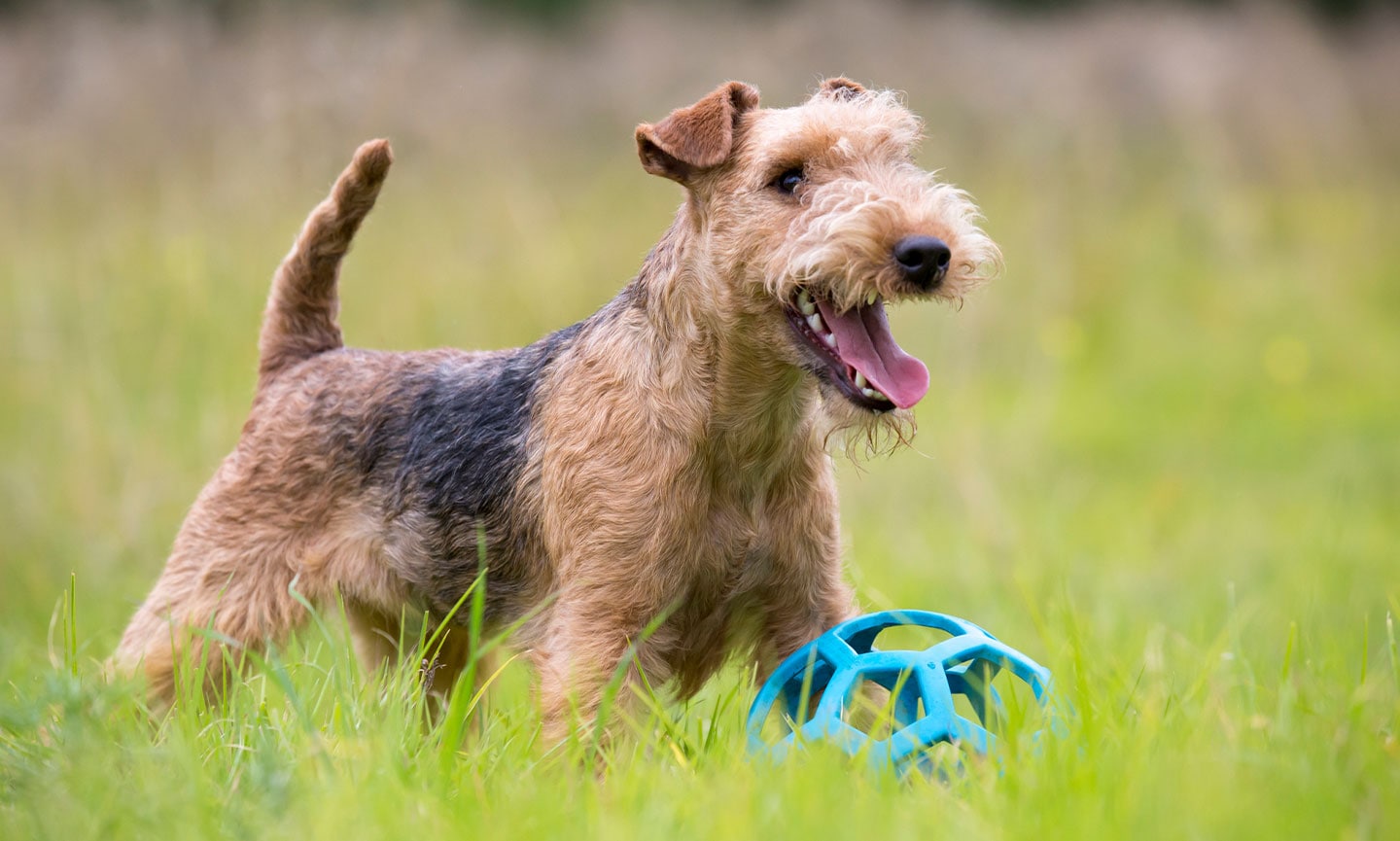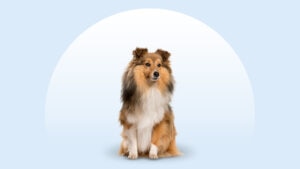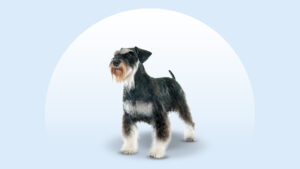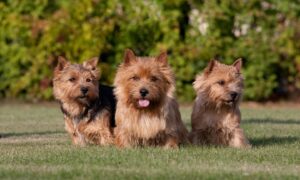Lakeland Terrier
Updated May 5, 2025
Lakeland Terrier
Updated May 5, 2025
Lakeland Terriers are energetic and affectionate dogs known for their adventurous spirit. They thrive in homes with experienced pet parents who can provide plenty of playtime and outdoor activity.
Playful, Quirky, Mischievous
Male: 17 lbs
Female: Slightly smaller
Male: 14-15 inches
Female: Slightly smaller
12 to 15 years
Black, Black and Tan, Blue, Blue and Tan, Grizzle and Tan, Liver, Red, Red Grizzle, Wheaten
The Lakeland Terrier is curious, bold and loves to play. Lakies, as they’re affectionately known, enjoy a good adventure. These curious pups never leave a good mystery unsolved, whether that’s an interesting scent on a nature hike or a puzzle toy they know is hiding a delicious treat. Lakies love to be busy, but once they’ve solved today’s mystery, they’re cool to hang out on the patio with you and recount their discoveries—and maybe snack on a treat or two.
Lakeland Terrier Characteristics
Lakeland Terrier Appearance
The Lakeland Terrier’s square-set jaw, sturdy build and twinkling eyes let you know right away that their small size is no indication of a lack of personality. With a wispy, wiry coat and distinguished beard, this handsome pup is full of charm and character.

- Ears
They have small, folded and V-shaped ears.
- Eyes
Small and oval, Lakeland Terrier eyes are set somewhat far apart and range in color from warm brown to dark hazel to black.
- Nose
They have a black or liver-colored (reddish brown) nose.
- Coat Length
Lakeland Terriers have a double coat with a hard, wavy and wiry outer coat and a soft, dense and temperature-regulating undercoat.
- Coat Color
The Lakeland Terrier breed may be either solid-colored or saddle-marked. Common colors include blue, black, liver (reddish brown), red, wheaten, and shades of grizzle (a mix of black hairs and another color) and tan.
- Tail
They typically have a high-set tail carried with pride—upright and with a slight curve.
Lakeland Terrier Temperament
Lakeland Terriers are feisty pups who look forward to adventures with you. With their intelligence and curious nature, Lakies really enjoy exploring, whether that’s a walk in the neighborhood or a hike down a wooded path where they can run on a leash and discover scents with their nose.
Plenty of play that exercises their minds and bodies will keep them happy, content and out of mischief. They’re known to create their own entertainment if they get bored, like digging holes in the yard. (Didn’t you want that new bush over here?)
Lakeland Terriers love their families and are great playmates for children. However, socialization starting when they’re a puppy is important to help these pups get used to kids. Lakies can be wary of strangers and may feel the need to protect their food or toys, or feel threatened if they’re being cornered. So, they may misinterpret a toddler’s exuberant, quick movements and react. It’s important to supervise all playtimes with your dog and small kids, and teach every child in your dog’s life how to play nicely with your pup.
Lakies can get along with other dogs they’ve grown up with, but they might never be a cat’s BFF. Lakelands have a strong prey drive to chase cats and other small pets, like rabbits or gerbils.
These confident pups make great watch dogs. Lakies are quick to bark at new sights and sounds—whether they see a squirrel in the backyard or a guest approaching the home.
Their confident and independent nature likely comes from their fox-hunting history. They started out as farm dogs raised to guard sheep, and the foxes they chased were often bigger than them. Now, that’s a confident pup!
How to Care for a Lakeland Terrier
Despite a Lakeland Terrier’s independent nature, they do need their pet parents for a few key things—including consistent grooming, training and exercise—to look, feel and behave their best.
Grooming
Training
Diet
Exercise
Environment
Lakeland Terrier Health
Lakeland Terriers have a lifespan of 12 to 15 years, and these pups aren’t as popular as some of their cousins. Because they’re not bred as frequently, they have fewer health issues than some other terrier breeds. Being aware of their most common medical concerns can help your pup live the healthiest life possible.
- Hypothyroidism: This is a condition in which the thyroid gland doesn’t produce enough hormones. Luckily, this is typically easily treated by giving your dog thyroid medication every day. When detected early, it usually doesn’t impact the animal’s quality of life.
- Eye Problems: Lakeland Terriers’ eyes can be susceptible to issues like lens luxation (an inherited eye condition) and distichiasis (unusual hair growth in the eye area). Glaucoma and cataracts may also be common in older Lakies. If your pup is having any issues with their eyes (redness, cloudiness, bulging, squinting or pain), see your vet immediately. Depending on the underlying problem, they may refer you to a veterinary ophthalmologist for advanced diagnostics or treatment options.
- Legg-Calve-Perthes Disease: This inherited hip disease occurs due to deterioration of the ball portion (femoral head) of the hip socket. This painful condition is often treated with surgery.
- von Willebrand’s Disease (vWB): This inherited bleeding disorder causes the dog’s blood not to clot properly. Most affected dogs live normal day-to-day lives, but unexpected bleeding can occur during surgery, even routine procedures. Genetic screening testing is available so be sure to ask your breeder.
Lakeland Terrier History
The Lakeland Terrier is named for the Lake District of Northern England, where they were bred as farmers’ dogs and tasked with critical jobs like protecting land and sheep, keeping farms free from pests and hunting foxes. The breed’s hard-working attitude persists today, as does their fearlessness, pride and intelligence.
A few other terrier breeds have similar origin stories: You’d be forgiven for confusing the Lakeland Terrier with their slightly larger cousin, the Welsh Terrier—similar in disposition and physical characteristics, the two are sometimes mixed up for each other. (Hint: The Welsh Terrier is slightly larger and is only black and tan. Lakies come in more color options.)
Thanks to their confident poise and undeniable handsomeness, Lakies can make excellent show dogs. In fact, in 1967 a Lakeland Terrier—Champion Stingray of Derryabah—was the first dog to win Best in Show at both Crufts and Westminster.
The American Kennel Club (AKC) recognized the Lakeland Terrier dog in 1934. Are you looking to add a like Lakie love in your life? You can find a list of reputable breeders on the AKC website. Lakeland Terrier puppy price ranges from $1,200 to $1,800. But for that, you’re likely getting a pup who’s been screened for health and temperament issues and may come with pedigree papers. If you’d like to adopt a pup, contact the United States Lakeland Terrier Club for rescue pups, keep an eye out for the breed at your local animal shelter, or search Chewy’s database of adoptable dogs in your area.
FAQs
Do Lakeland Terriers shed?
Are Lakeland Terriers good pets?
How long do Lakeland Terriers live?
Do Lakeland Terriers bark a lot?
What are the most common Lakeland Terrier mixes?
Expert input provided by veterinarian Dr. Cori Wigfall, DVM, BVM and veterinary spokesperson of SpiritDog Training; certified dog trainer Kate LaSala, CTC, CBCC-KA, PCBC-A, CSAT, owner of Rescued By Training; and breed expert Pat Rock, breeder of Lakeland Terriers for 50 years.
Breed characteristic ratings provided by veterinarian Dr. Sarah J. Wooten, DVM, CVJ, a veterinarian at Sheep Draw Veterinary Hospital in Greeley, Colorado; dog trainer and behavior consultant Irith Bloom, CPDT-KSA, CBCC-KA, CDBC, owner of The Sophisticated Dog, LLC, in Los Angeles; and certified animal behavior consultant Amy Shojai, CABC, in Sherman, Texas.
The health content was medically reviewed by Chewy vets.








